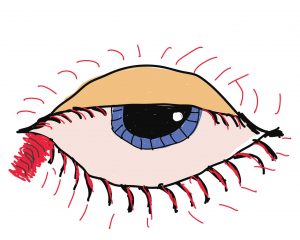 13th February 2019, Dr Chee L Khoo
13th February 2019, Dr Chee L Khoo
Nasolacrimal duct obstruction in infants is not uncommon. Up to 10% of infants will present with watery, teary eyes which sometimes become purulent necessitating antibiotic drops. We know that “most” spontaneously resolve as the infant grows older. In the meantime, we generally recommend massaging of the duct and topical antibiotics when required. Up to 1 in 4 congenital nasolacrimal duct obstruction (CNLDO) does not resolve spontaneously. These infants go on to have mechanical probing of the duct. Is there an optimal time to probe the obstruction? When is it time to refer?
Because “most” of these obstructions resolve spontaneously, some experts propose waiting until the child is aged 12 or 13 months to probe. Does it matter, if we wait a bit longer and probe the nasolacrimal duct later? Well, unfortunately, delaying probing can increase the risk of inflammation and fibrosis, which may decrease the success rates of subsequent probings (1-3). So, what is the optimal time to probe?
Saraniya Sathiamoorthi et al retrospectively reviewed the medical records of 1998 consecutive patients < 5 years diagnosed as having CNLDO in Olmsted County, Minnesota, from January 1, 1995 – December 31, 2004. Of the 1998 infants reviewed, 1669 (83.5%) spontaneously resolved while 289 (14.5%) required surgical treatment. 40 were lost to follow up.
Of those that spontaneously resolve, most were diagnosed at 1 month old. The median age of resolution was 2.4 months. The rate of resolution was highest at the first few months of life and decline until 9 months when the rate of resolution plateaued. Boys’ obstruction resolved 0.5 months faster. Unilateral obstruction resolved 0.2 months faster than bilateral obstructions.
Of the infants that require surgical treatment, the diagnosis was made at 6.0 months. Children probed at 15 months or older had decreased odds of resolution after probing (OR, 0.11; 95% CI, 0.01-0.89; P = .04) relative to children probed at age 12 to 14 months. Children probed younger than 12 months had the same success rate with those probed at 12-14 months.
In summary, the majority of kids with CNLDO resolve spontaneously. As the kid gets older, the chances of spontaneous resolution decreases. Beginning at soon after birth, the spontaneous resolution rate declines by approximately 30% every 3 months until age 9 months, at which time the rate plateaus.9 out 10 kids who spontaneously resolved, did so by 9 months old.
In a number of studies (4-8) the success rate of those probed before 12 months were 90% while those probed after 12 months, the success rate dropped to 50-70%. This study confirmed the negative association between age of surgery and success rate post op. The poorer results in older children have been attributed to the development of more complicated obstructions from chronic infections and scarring.
The authors concluded that “Given that the rate of spontaneous resolution appears to plateau after age 9months and a successful probing outcome declines beyond age 15 months, surgical intervention between these time intervals appears to be a reasonable treatment strategy for infants with nasolacrimal duct obstruction”
Access the abstract here.
References
- Robb RM. Success rates of nasolacrimal duct probing at time intervals after 1 year of age. Ophthalmology. 1998;105(7):1307-1309.
- Ffooks OO. Dacryocystitis in infancy. Br J Ophthalmol. 1962;46(7):422-434.
- Weil BA. Dacryocystitis. In: Viers ER, ed. The Lacrimal System, Proceedings of the First International Symposium. St. Louis, MO: CV Mosby Co; 1971: 118.
- Katowitz JA,Welsh MG. Timing of initial probing and irrigation in congenital nasolacrimal duct obstruction. Ophthalmology. 1987;94(6):698-705.
- Janssen AG, Mansour K, Bos JJ, Castelijns JA. Diameter of the bony lacrimal canal: normal values and values related to nasolacrimal duct obstruction: assessment with CT. AJNR Am J Neuroradiol. 2001; 22(5):845-850.
- Mannor GE, Rose GE, Frimpong-Ansah K, Ezra E. Factors affecting the success of nasolacrimal duct probing for congenital nasolacrimal duct obstruction. Am J Ophthalmol. 1999;127(5):616-617.
- Kashkouli MB, Beigi B, Parvaresh MM, Kassaee A, Tabatabaee Z. Late and very late initial probing for congenital nasolacrimal duct obstruction: what is the cause of failure? Br J Ophthalmol. 2003;87 (9):1151-1153.
- Ciftçi F, Akman A, Sönmez M, Unal M, Güngör A, Yaylali V. Systematic, combined treatment approach to nasolacrimal duct obstruction in different age groups. Eur J Ophthalmol. 2000;10 (4):324-329.
- Saraniya Sathiamoorthi,; Ryan D. Frank; Brian G. Mohney. Spontaneous Resolution and Timing of Intervention in Congenital Nasolacrimal Duct Obstruction. JAMA Ophthalmol. 2018;136(11):1281-1286. doi:10.1001/jamaophthalmol.2018.3841
